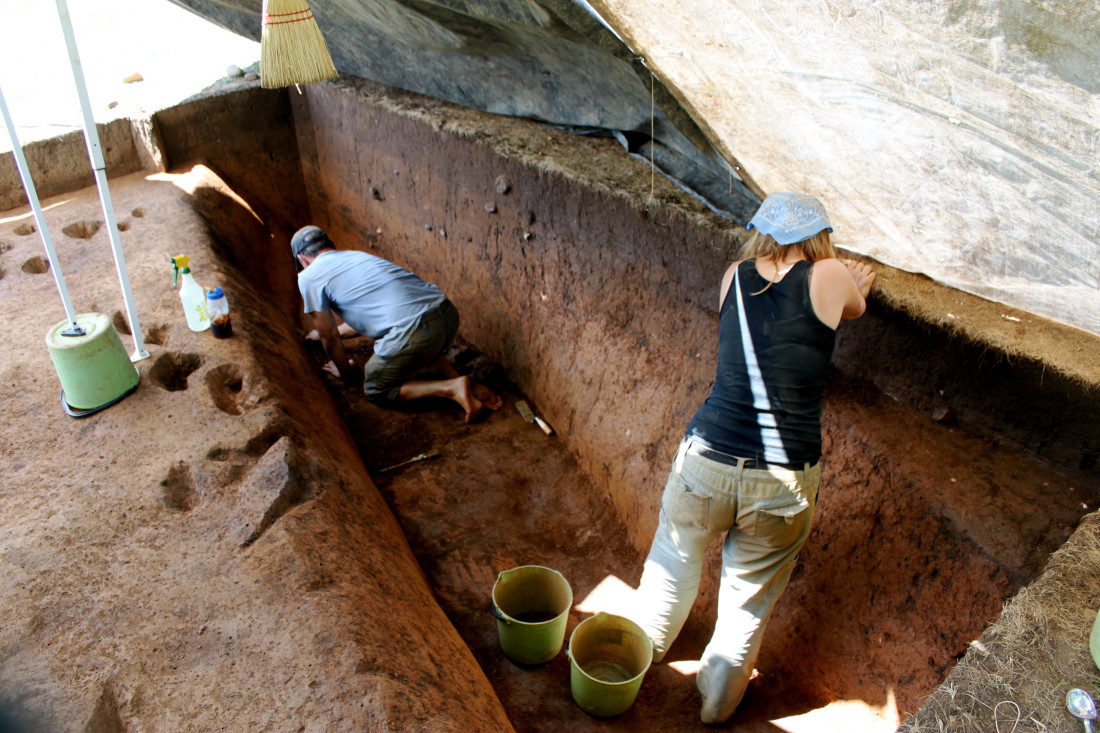Nearly 2,000 years ago, Native Americans in the Southern Appalachian Mountains established a seasonal gathering place in what is now a neighborhood outside Canton. Discoveries at this site, known as Garden Creek, suggest it served as a home for native craftspeople who produced artifacts for a religious and cultural movement that swept ancient North America.
Alice Wright, an archaeologist at Appalachian State University who served as director of the Garden Creek Archaeological Project, believes excavations done at the site in 2011-12 show Native Americans in the Blue Ridge had closer ties than previously thought with the Hopewell culture. Those native populations were named by archaeologists for a site in southern Ohio that was the source of some early finds. The culture flourished between 100 and 400 B.C. and is marked by its architecture (ceremonial mounds and ritual enclosures marked off by earthworks) and the artifacts used in religious ceremonies. Astonishingly, excavations at sites in the center of this culture have unearthed artifacts crafted from exotic material — copper from Canada, seashells from the Gulf Coast, huge deposits of obsidian ferried all the way from Wyoming and ritual artifacts cut from mica mined here, in the Southern Appalachians.
Until recently, Wright says, archaeologists thought that any traces of Hopewell culture found at the sources of these materials proved only that these far-flung communities of people had adopted a thin veneer of Hopewell ritual on top of their local traditions. But, based on the discoveries made by the team at Garden Creek, Wright says, “I’m convinced that local Appalachian communities were much more involved.”
Southern Appalachia, where mica was mined on an industrial scale in the 19th and 20th centuries, long seemed the obvious source for the quantities of the mineral used in Hopewell rituals. But the excavations at Garden Creek provided some of the first compelling evidence that indigenous people may have crafted the artifacts at the source.

In particular, digs at Garden Creek revealed traces of two large enclosures bordered by earthworks. These echo similar structures in the Hopewell center and may have marked off areas for performing ceremonies and ritual tasks. Excavations in and around these enclosures unearthed significant deposits of mica, mostly scraps bearing evidence of having been deliberately cut away from larger sheets. This suggests that craftspeople manufactured artifacts in and around these enclosures. “When the site was in use, and when the site was abandoned, there were ritual activities going on,” Wright says. “And crafting was a part of these ritual activities.”
No finished mica artifacts have been found at Garden Creek. Their absence suggests that whoever manufactured the artifacts unearthed at the Hopewell center carried the finished items on an arduous 500-mile journey to what is now southern Ohio, possibly as a form of pilgrimage.
“How would people in North Carolina know that there was this incredible explosion of religious activity in Ohio?” Wright asks. “What would compel them to go check it out? I don’t know.” What role the artifacts might have played in Hopewell ritual is likewise a subject of speculation.
Wright is more sure about why Native Americans found mica so fascinating.
Calling the cut mica art pieces “incredibly beautiful,” Wright says, “You’re digging into the earth, and that’s a significant symbolic thing. Also, [mica has] natural qualities. It can be light and dark at the same time, it’s reflective, it’s got this translucence to it. Different sorts of qualities may have given it symbolic import that made it worthy of ritualization.”
Garden Creek may not be the only crafting site waiting to be discovered. Remains of a roughly contemporary settlement have been found on the Biltmore Estate, and farming and development have likely claimed other sites. Indeed, Wright points out that the Garden Creek site was only discovered as land was cleared for a house. But, just as today’s Appalachian craftspeople are now revealed as stewards of a tradition that goes back two millennia, the residents of Garden Creek have chosen to preserve the traces of culture that have come to light almost literally beneath their feet.
“I’m grateful for it,” Wright says. “And I hope future generations of archaeologists will be grateful for it, too.”



Before you comment
The comments section is here to provide a platform for civil dialogue on the issues we face together as a local community. Xpress is committed to offering this platform for all voices, but when the tone of the discussion gets nasty or strays off topic, we believe many people choose not to participate. Xpress editors are determined to moderate comments to ensure a constructive interchange is maintained. All comments judged not to be in keeping with the spirit of civil discourse will be removed and repeat violators will be banned. See here for our terms of service. Thank you for being part of this effort to promote respectful discussion.